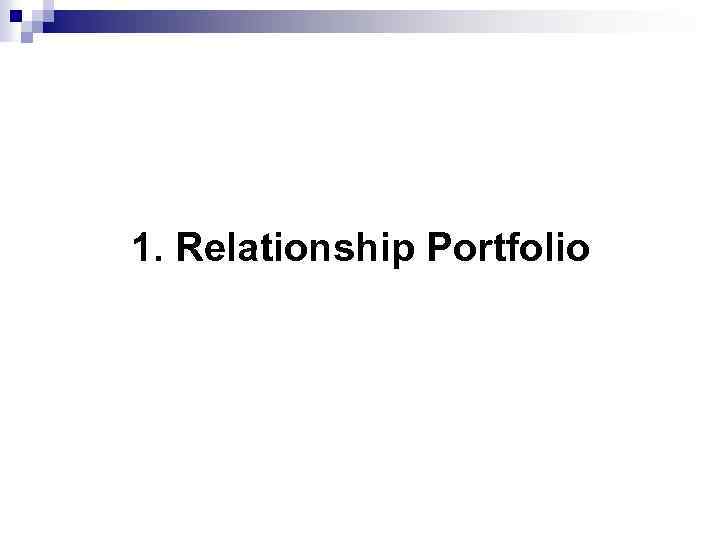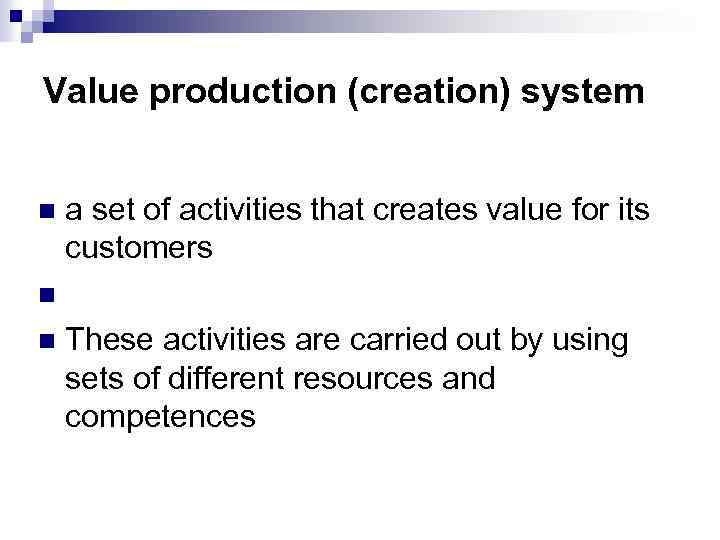Портфель.ppt
- Количество слайдов: 22
 Developing relationship marketing strategy 09. 10. 2012
Developing relationship marketing strategy 09. 10. 2012
 1. Relationship Portfolio
1. Relationship Portfolio
 Relationship Portfolio n The aim of traditional portfolio management is to achieve balance n Relationship portfolios help managers to decide on resource allocation decisions to relationships n Two main stages – ¨ identification and classification of relationships; ¨ creation of a “balanced” structure
Relationship Portfolio n The aim of traditional portfolio management is to achieve balance n Relationship portfolios help managers to decide on resource allocation decisions to relationships n Two main stages – ¨ identification and classification of relationships; ¨ creation of a “balanced” structure
![Involvement and Continuity of Relationships [Ford] Low involvement High continuity 1 2 Low continuity Involvement and Continuity of Relationships [Ford] Low involvement High continuity 1 2 Low continuity](https://present5.com/presentation/3/32111816_134290839.pdf-img/32111816_134290839.pdf-4.jpg) Involvement and Continuity of Relationships [Ford] Low involvement High continuity 1 2 Low continuity 3 4
Involvement and Continuity of Relationships [Ford] Low involvement High continuity 1 2 Low continuity 3 4
 Involvement and Continuity Relationships - 1 Low involvement High continuity Low continuity High involvement 1 2 Long-term arm’s – length relationship • • rouitinisation. 3 Continuity allows makes changes of 4 Low involvement partner easy
Involvement and Continuity Relationships - 1 Low involvement High continuity Low continuity High involvement 1 2 Long-term arm’s – length relationship • • rouitinisation. 3 Continuity allows makes changes of 4 Low involvement partner easy
 Involvement and Continuity Relationships - 2 Low involvement High continuity Low continuity 1 High involvement 2 Long-term intensive relationship • Efficiency improvement through adaptations leads to cost and 4 3 revenue benefits over time
Involvement and Continuity Relationships - 2 Low involvement High continuity Low continuity 1 High involvement 2 Long-term intensive relationship • Efficiency improvement through adaptations leads to cost and 4 3 revenue benefits over time
 Involvement and Continuity Relationships - 3 Low involvement High continuity Short-term, arm’s-length relationships 1 2 • Low continuity High involvement 3 Increasing efficiency from price pressure, requiring low continuity and low involvement 4
Involvement and Continuity Relationships - 3 Low involvement High continuity Short-term, arm’s-length relationships 1 2 • Low continuity High involvement 3 Increasing efficiency from price pressure, requiring low continuity and low involvement 4
 Involvement and Continuity Relationships - 3 Low involvement High continuity Low continuity High involvement Short-term, intense relationships 1 2 • Appropriate for buying complex systems and equipment bought infrequently 3 4
Involvement and Continuity Relationships - 3 Low involvement High continuity Low continuity High involvement Short-term, intense relationships 1 2 • Appropriate for buying complex systems and equipment bought infrequently 3 4
![E. g. Relationship portfolio [Donaldson, O’Toole, 2000] E. g. Relationship portfolio [Donaldson, O’Toole, 2000]](https://present5.com/presentation/3/32111816_134290839.pdf-img/32111816_134290839.pdf-9.jpg) E. g. Relationship portfolio [Donaldson, O’Toole, 2000]
E. g. Relationship portfolio [Donaldson, O’Toole, 2000]
![E. g. Customer classification portfolio: assessment of the contribution of relationships [Turnbull, Zolkiewski, 1997] E. g. Customer classification portfolio: assessment of the contribution of relationships [Turnbull, Zolkiewski, 1997]](https://present5.com/presentation/3/32111816_134290839.pdf-img/32111816_134290839.pdf-10.jpg) E. g. Customer classification portfolio: assessment of the contribution of relationships [Turnbull, Zolkiewski, 1997]
E. g. Customer classification portfolio: assessment of the contribution of relationships [Turnbull, Zolkiewski, 1997]
![E. g. Frequency of relationships [Bensaou, 1999] E. g. Frequency of relationships [Bensaou, 1999]](https://present5.com/presentation/3/32111816_134290839.pdf-img/32111816_134290839.pdf-11.jpg) E. g. Frequency of relationships [Bensaou, 1999]
E. g. Frequency of relationships [Bensaou, 1999]
![E. g. [Wilson, 1995] Amount of operating risk associated with doing business with the E. g. [Wilson, 1995] Amount of operating risk associated with doing business with the](https://present5.com/presentation/3/32111816_134290839.pdf-img/32111816_134290839.pdf-12.jpg) E. g. [Wilson, 1995] Amount of operating risk associated with doing business with the seller Value added to the buyer's product by the seller
E. g. [Wilson, 1995] Amount of operating risk associated with doing business with the seller Value added to the buyer's product by the seller
![Model of relationship development process [Wilson, 1995] (1) 1. Partner selection ¨ 2. Defining Model of relationship development process [Wilson, 1995] (1) 1. Partner selection ¨ 2. Defining](https://present5.com/presentation/3/32111816_134290839.pdf-img/32111816_134290839.pdf-13.jpg) Model of relationship development process [Wilson, 1995] (1) 1. Partner selection ¨ 2. Defining purpose ¨ 3. degree to which each partner penetrates the other organization Creating relationship value ¨ 5. Tradeoff between mutual and individual goals Setting relationship boundaries ¨ 4. Exploration stage in Dwyer and Schurr’s model Competitive abilities of the partners are enhanced being in the relationship Relationship maintenance ¨ Activities aimed at broadening the scope of relationships, increasing its longevity, level of parties' involvement etc.
Model of relationship development process [Wilson, 1995] (1) 1. Partner selection ¨ 2. Defining purpose ¨ 3. degree to which each partner penetrates the other organization Creating relationship value ¨ 5. Tradeoff between mutual and individual goals Setting relationship boundaries ¨ 4. Exploration stage in Dwyer and Schurr’s model Competitive abilities of the partners are enhanced being in the relationship Relationship maintenance ¨ Activities aimed at broadening the scope of relationships, increasing its longevity, level of parties' involvement etc.
 Relationship development process and relationship variables (2)
Relationship development process and relationship variables (2)
 Trust n n n Trust – confidence in exchange partner’s reliability and integrity [Morgan, Hunt, 1994] Trust – one party’s belief that its needs will be fulfilled in the future by actions taken by the other party [Anderson and Weitz, 1992] Three dimensions – ¨ ¨ ¨ n n credibility (keeping promises) benevolence (doing more than expected, goodwill) competence (perform role completely). Trust is considered to be one of the main antecedents of relationship development But is trust antecedent or consequence of relationship?
Trust n n n Trust – confidence in exchange partner’s reliability and integrity [Morgan, Hunt, 1994] Trust – one party’s belief that its needs will be fulfilled in the future by actions taken by the other party [Anderson and Weitz, 1992] Three dimensions – ¨ ¨ ¨ n n credibility (keeping promises) benevolence (doing more than expected, goodwill) competence (perform role completely). Trust is considered to be one of the main antecedents of relationship development But is trust antecedent or consequence of relationship?
 Commitment n n Enduring desire to maintain a valued relationship [Moorman et al. , 1993] It is based on the belief that a relationship is worth the effort to be maintained. Represents the importance of relationship and desire to continue it Two dimensions Input (information, investments) ¨ Continuance (longevity) ¨
Commitment n n Enduring desire to maintain a valued relationship [Moorman et al. , 1993] It is based on the belief that a relationship is worth the effort to be maintained. Represents the importance of relationship and desire to continue it Two dimensions Input (information, investments) ¨ Continuance (longevity) ¨
![Trust and Commitment theory [Morgan, Hunt, 1994] Key Mediating Variable (KMV) model Trust and Commitment theory [Morgan, Hunt, 1994] Key Mediating Variable (KMV) model](https://present5.com/presentation/3/32111816_134290839.pdf-img/32111816_134290839.pdf-17.jpg) Trust and Commitment theory [Morgan, Hunt, 1994] Key Mediating Variable (KMV) model
Trust and Commitment theory [Morgan, Hunt, 1994] Key Mediating Variable (KMV) model
 Determinants of interorganizational competitive advantage Relational Resources Organizational Relational Competences Relational competitive advantage Development of firms relational resources and competeces contributes to superior relationship value creation that leads to superior financial performance
Determinants of interorganizational competitive advantage Relational Resources Organizational Relational Competences Relational competitive advantage Development of firms relational resources and competeces contributes to superior relationship value creation that leads to superior financial performance
 2. Relationship Value “The biggest risk of all is creating relationships without considering how value will be created” [Ballantyne, 2000]
2. Relationship Value “The biggest risk of all is creating relationships without considering how value will be created” [Ballantyne, 2000]
 Value concept in RM 1. 2. 3. 4. Customer value is a subjective concept It is conceptualized as a trade-off between benefits and sacrifices Benefits and sacrifices can be multifaceted Value perceptions are relative to competition [Ulaga, Eggert, 2005] Limitations of such view: 1) It views value predominantly from a buyer's perspective. 2) View is silent about the joint value creation requiring combined activities of the buyer and the seller.
Value concept in RM 1. 2. 3. 4. Customer value is a subjective concept It is conceptualized as a trade-off between benefits and sacrifices Benefits and sacrifices can be multifaceted Value perceptions are relative to competition [Ulaga, Eggert, 2005] Limitations of such view: 1) It views value predominantly from a buyer's perspective. 2) View is silent about the joint value creation requiring combined activities of the buyer and the seller.
 Value production (creation) system n a set of activities that creates value for its customers n n These activities are carried out by using sets of different resources and competences
Value production (creation) system n a set of activities that creates value for its customers n n These activities are carried out by using sets of different resources and competences
 Basic value strategies
Basic value strategies


